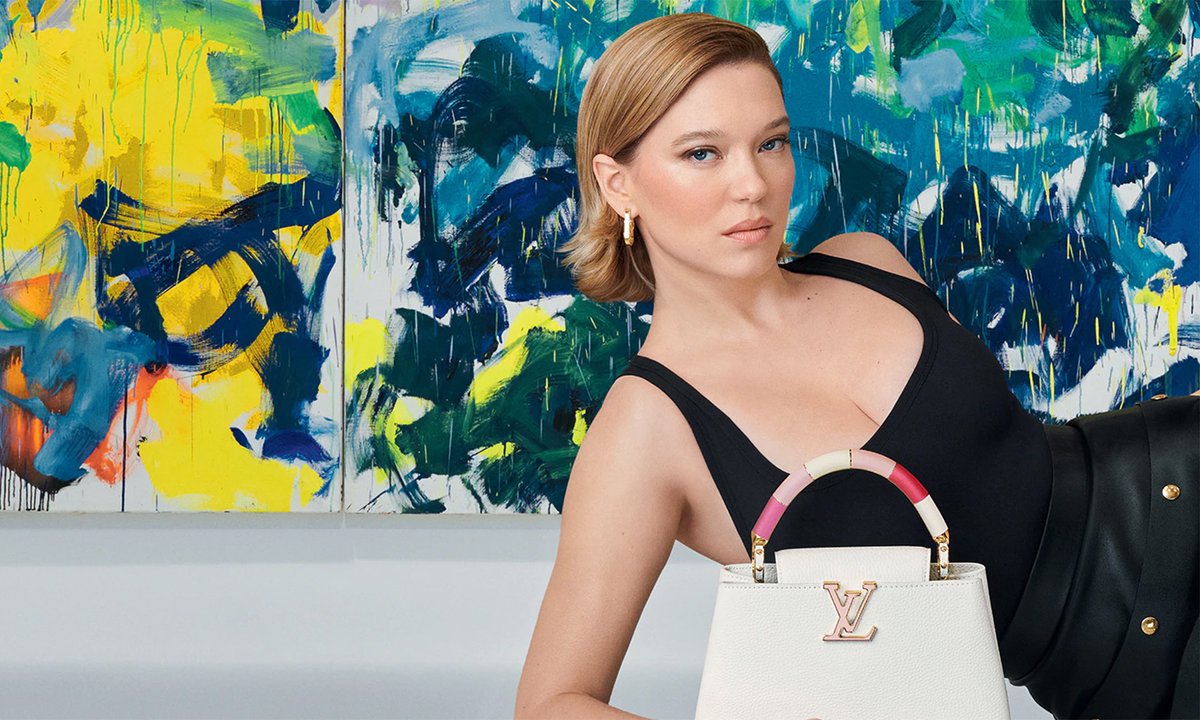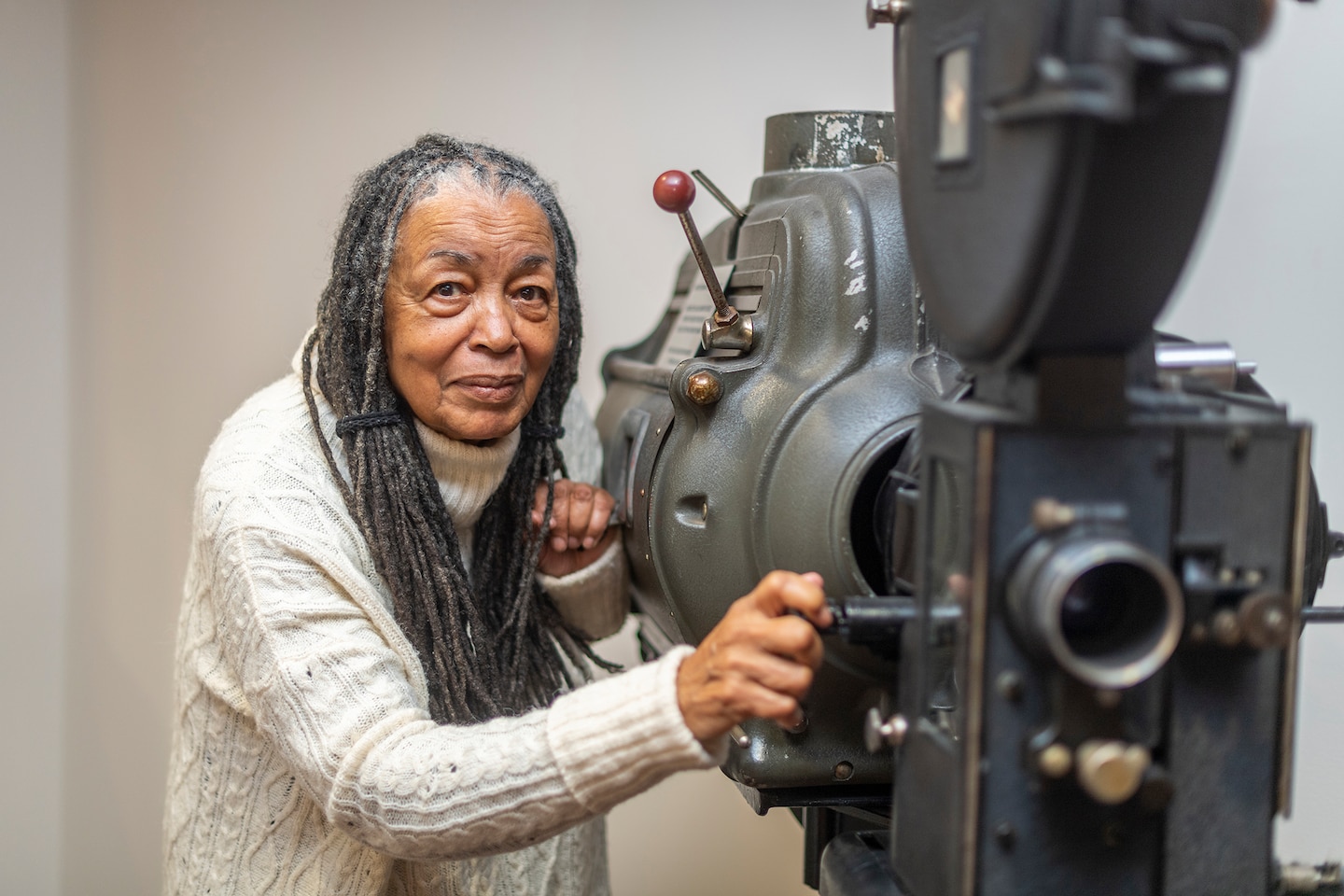IN HER 1997 DIPTYCH VENERE ALPINA, Kay WalkingStick sets a painted image of a hulking mountain in the American Rockies beside a dramatic umber slit. The artist sliced open the brown canvas, bisecting it vertically, and under the crisp incision, a crusty layer of fake gems sparkles in the light. Here as elsewhere, WalkingStick makes the land feel corporeal as she tends to its wounds.
A member of the Cherokee Nation who is also of European descent, WalkingStick has been exploring relationships between people and the earth for five decades. Diptychs are her signature format: often, she pairs landscapes with abstractions. Since the 1960s, her output has been marked by impressive range. During the ’70s, at the height of the feminist art movement, she painted brightly hued images of her nude form. In the decades following, she took up various triumphs of Native American culture alongside tragedies of Native history. Among her few sculptures is Tears (1990), representing a traditional Plains Indian funerary scaffold, but this version is embossed with a poem identifying the structure as a memorial to those lost, and to those never born. It’s a piece about Native grief that WalkingStick made in anticipation of the quincentennial of Columbus’s 1492 voyage.
Kay WalkingStick: Farewell to the Smokies (Trail of Tears), 2007.
Courtesy Denver Art Museum
WalkingStick has long been revered in the Native American community. Several key surveys of Indigenous art organized by artist Jaune Quick-to-See Smith have included her paintings. Feminist critics such as Lucy Lippard have also lauded her, writing that WalkingStick’s recent landscapes “brilliantly achieve the unity that is her aesthetic goal.” The National Museum of the American Indian put on her 2015 touring retrospective, helping secure her spot on the institutional map. Today, her work is on view in the Museum of Modern Art and the Metropolitan Museum of Art, both in New York, and her solo show at the New-York Historical Society runs through April 14. For the latter show, WalkingStick hung her signature two-panel landscapes, superimposed with traditional Native patterning, among works by Hudson River School painters. She borrowed these historic compositions, but overlaid them with recognizably Indigenous imagery—like Native patterning, or silhouettes walking the Trail of Tears—refuting those painters’ false depictions of land that lay vacant before colonizers arrived.
Below, WalkingStick discusses her approach to painting—and probing— landscapes, all the while looking past the land’s surface to unearth its wounds.
In your diptychs, you seem to establish binaries—between figuration and abstraction, for example, or land and people. But there is often a lot of continuity beyond the harsh juxtaposition a diptych might imply. How do you approach flipping between either/or and both/and?
Whenever I talk about my paintings, I start by saying I’m a biracial Cherokee woman. Of course, that impacts the work, and I suppose this impact is most evident in the diptychs. The [nonfigurative half of a diptych] is never an abstraction of the other—it’s an extension. It tells more of the story. I’ve often thought of each panel as the inside or the outside of the painting’s subject. The inside is the spiritual side, the one that has to do with the soul. So one side involves seeing the present—it often looks like a snapshot—and the other might involve the deeper meaning of the present, or the future.
When people see the diptychs, they’re going to see whatever they want to see. Some people just see geological history, and that’s a valid way to look at them. There are just so many ways to see a piece of art that are valid; that’s what keeps our historians working.
Your work has drawn on so many different eras of art history, from 14th-century Italian icons to 19th-century Hudson River School landscapes. How has your relationship to art history changed over the years?
Well, I think I got a better education in art history than young people get today, judging from what I hear and see. I had good art history classes in my undergraduate and graduate schools, and my vacations are usually to visit museums. I’ve been heavily influenced by European art and American art, whether it was Native or Indigenous art, or art by Euro- Americans. The New-York Historical Society sensed this when they reached out to me.
Many of your paintings are very sensual. Your landscapes often feel corporeal— landforms have warm, fleshy undertones, landscapes are shown next to breasts. What is the importance of sensuality to your work?
The act of painting is sensual. For me, if it’s not sensual, it’s not painting! Night/ƠRT (Usvi) [1991], a painting owned by the Montclair Art Museum in New Jersey, shows a riverbed at night. I made the abstract panel of that painting using my hands [instead of a brush]. I was physically playing with the paint. For me, all my abstractions, all my diptychs—making them was a sensual act.

Kay WalkingStick: Night/O’RT (Usvi), 1991.
Photo Peter Jacobs/Courtesy Montclair Art Museum
Sometimes, you mix your paint with natural materials, like rocks and sand, which causes it to appear rough. At other points, you’ve used encaustic, resulting in paintings that feel chunky. What made you want to do that?
I love the way it looks, I love the way it feels, I love the way it smells. With the works made with acrylic and wax, I liked what [the paint] did when it was piled up. And of course, when it’s made out of beeswax and acrylic and an emulsifier, the smell of it is heavenly—it’s like honey. So, I liked the look of the paint when it was very dense, but then, oddly, I stopped liking it for about 12 years.
What changed?
I just didn’t like the way it looked. But part of it, I think, was moving around the country, seeing different landscapes. And eventually, I went to Rome [during the ’90s, while teaching at the Cornell University campus there], and there were so many wonderful paintings there. I was doing paintings on paper in my little apartment, and I started using figures. Change doesn’t happen quickly for me. But over a few years, the paintings just sort of evolved.
How do you get to know a landscape before you paint it?
I do a lot of drawing, but I don’t necessarily use those drawings in the painting. I draw a place from a number of different viewpoints, so that the scene really gets in my head. It’s useful for me to have a solid idea of what a place looks like and feels like. After that, I usually take photographs. But photographs are always a problem because they’re not what the eye sees. You lose a lot of depth perception, and the blacks drop out; information in the dark areas gets lost. Photography is just useless unless you have a lot of equipment and knowledge about how to take photographs. It’s not totally dependable, you have to fill them in with memory. So after I make photographs, I often come home and make color drawings or oil sketches on paper.

Kay WalkingStick: Our Land Variation II, 2008.
Courtesy Hales, London and New York/Photo JSP Art Photography
And how much do you research the history of these landscapes?
It depends on the place. For instance, if I’m in Navajo country, it’s so easy to find great patterns [to superimpose on the landscape paintings], since they do all that wonderful rock art. I use these maps showing where different tribes lived, so if you’re looking at Wyoming, for instance, you can look up where the Shoshone lived. They’re related to the Crow and the Nez Perce, and they make marvelous parfleche bags, so they have perfect patterns to use in a painting. They’re not too curvilinear, so I can cut them with a stencil.
But I can’t always find what I’m looking for. I went to see the glaciers in Banff, and I looked for the people who lived in that area, the Nakoda. But they’re not allowed to live there—the Canadian government took over that land, so they’ve all been removed from their ancestral home. Only about 12 years ago were they allowed back into the park to have their ceremonials. It’s a disgusting history. So, I couldn’t find anything about the Nakoda—I looked everywhere. I finally called a friend, David Penney at the National Museum of the American Indian, who gave me some patterns. So, it goes from an easy find, like the Navajos, to a very difficult one, like the Nakodas.
Your “Chief Joseph” series, a group of paintings from between 1974 and 1976, is about a Nez Perce leader from the 19th century, but the imagery is mainly meandering lines against dark backgrounds. Does it bother you if not everyone gets his story from the paintings?
The subjects of all abstractions are identified by the artist. If an artist says, “This is about bloodlust or mother-and-child love,” you can attach that meaning to the painting. For me, the “Chief Joseph” pieces are about honoring the journey of Chief Joseph across Idaho and over the Bitterroot Mountains into Montana, and the battles that he fought in Montana with the American forces. It was a dark and difficult time for him. And it was a long journey. When you put them on the wall in the way I prefer them to be shown, which is a group of all of them together, it implies movement—rather slow movement. Sure, I’m assigning an idea to them, but that’s what artists do.
You’ve continued to paint during periods when some critics claimed the medium was dead. Did you ever feel pressure to change your work to meet the dominant modes of a specific moment?
No, not really. I was fortunate in that. When my kids were little, my first husband would basically take care of us. I got some part-time jobs, doing substitute teaching, and then taught adults painting at an art center for a while. But I didn’t have to get a full-time job. I didn’t have to sell art. I’ve always made paintings for myself and my family—and my own interior growth. I’ve never made paintings for clients. I didn’t feel like I had to make paintings for other people, ever. What a blessing.



